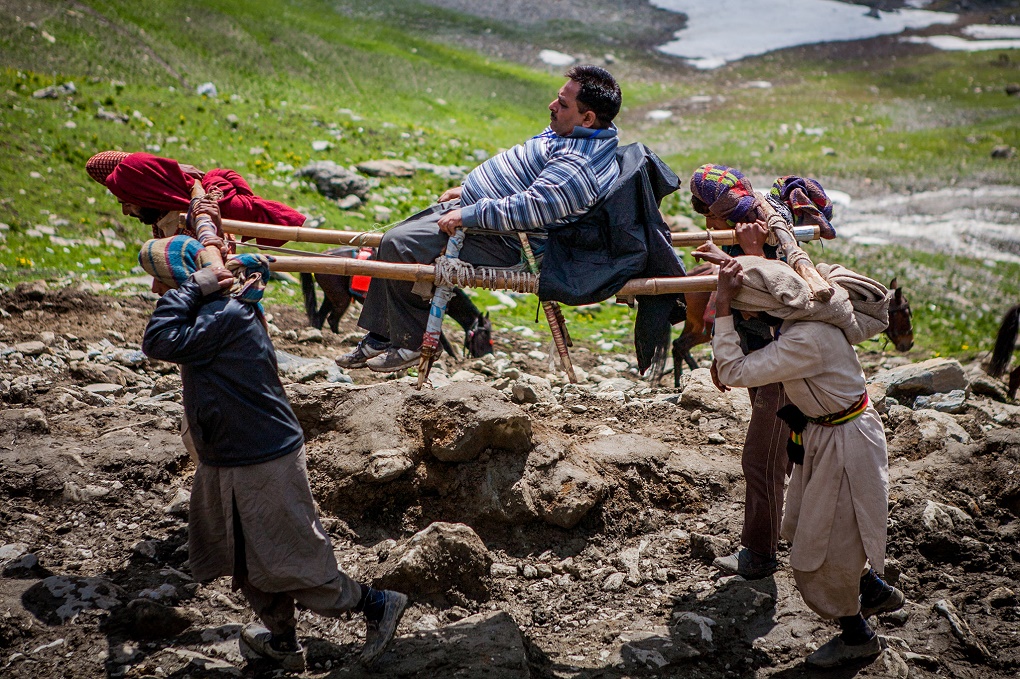Amidst demands that the number of pilgrims to the Amarnath cave in Kashmir – a site holy to Hindus – be reduced to prevent an environmental disaster, government officials in this northern Indian state have triggered a fresh controversy by apparently starting to build a paved road to the cave high up in the Himalayas.
Environmental activists and civil society members have asked officials not to undertake any construction activity along the way which leads to the Amarnath cave, thronged by hundreds of thousands of Hindu pilgrims annually. According to official figures, over three million people have made the pilgrimage in the last three years.
The state government has denied that it is planning to construct a paved road for the pilgrims through a forest, but the activists say they have photographs which show construction material at various sites in the forest.
The controversy started due to the increasing number of deaths among pilgrims. At least 130 died during the 2012 pilgrimage in July and August. India’s Supreme Court took note and asked the Jammu and Kashmir government to take immediate measures that would reduce the death toll.
Doctors traced these deaths to the poor health and unsatisfactory physical fitness of the pilgrims. “Acute mountain sickness, high altitude cerebral oedema and high altitude pulmonary oedema can happen even to healthy people if the basic principles of acclimatization are not adhered to. The health hazards are compounded among elderly people, persons with high blood pressure, heart disease, pulmonary insufficiency and diabetes,” observed Altaf Hussain, a noted medical expert based in Kashmir’s summer capital of Srinagar.

“I do not understand why the government is bent on making a paved road for the pilgrimage when it has been established by medical experts that the deaths have occurred due to health reasons, not because of (lack of) road infrastructure,” rights activist and lawyer Irfan Hafeez told thethirdpole.net.
“We hope environmental groups across the world and in India will join our efforts to ensure environmental preservation in the state in general and the route to the Amarnath cave in particular,” said Professor Hameeda Nayeem of Kashmir Centre for Social and Development Studies (KCSDS).
She and her colleagues are concerned by the gross degradation and vandalizing of the environment as a result of unregulated promotion of tourism and religious tourism beyond the standards of sustainability and the carrying capacity of fragile ecosystems.
Apart from opposing the construction of a paved road for the pilgrimage, environmentalists assert that the huge number of people trekking up to the cave every year is having a negative impact on the ecology of this fragile region. Over the past few years, they have continuously demanded government impose limits on the number of pilgrims.
Nayeem said her organisation appreciates the November 2010 direction of the federal government to declare as an eco-sensitive zone the 135-kilometre stretch of the Ganga between the mouth of the Gangotri glacier at Gaumukh and Uttarkashi. That is also a very popular pilgrimage for Hindus, but the number is restricted.
“We appeal to the government of India to issue similar orders for regulating religious tourism in the Kashmir Himalayas, for the conservation of environment and ecology,” she told thethirdpole.net.
“The Yatra [pilgrimage] time should be limited to 15 days (from the present two months) and a limited number of Yatris [pilgrims] should be allowed every day like in the case of Gangotri.”
Shahid Ahmed Wani, who teaches environmental science at Kashmir University, said that more people in the mountains mean more pollution. “The pollution in mountains is not only dangerous for wild animals, but also for human beings living in the plains. If you have more people visiting the Holy Cave, they will leave more trash along the way like we have seen in the past few years. What is more worrying is the fact that helicopters are also used for carrying the pilgrims, which is not a good idea. Such things should be avoided at all costs.”
Athar Parvaiz is a journalist based in Kashmir
![<p>A large number of pilgrims at 4,200 meters, has a heavy impact on the ecology [image by: sandeepachetan.com]</p>](https://dialogue.earth/content/uploads/2012/11/At-13800-ft-sandeepachetan.jpg)
